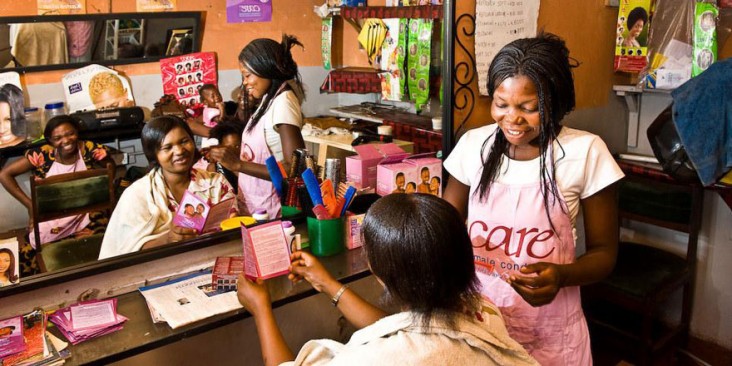- What We Do
- Agriculture and Food Security
- Democracy, Human Rights and Governance
- Economic Growth and Trade
- Education
- Ending Extreme Poverty
- Environment and Global Climate Change
- Gender Equality and Women's Empowerment
- Global Health
- Water and Sanitation
- Working in Crises and Conflict
- U.S. Global Development Lab

Who We Are
The U.S. Agency for International Development (USAID) has long been a leader in supporting the research and development (R&D) of safe, effective, and affordable microbicides – biomedical products that women can use to protect themselves from HIV infection. USAID especially focuses on the R&D of microbicides that can be sustainably provided in key focus countries in sub-Saharan Africa for the women who need them most, including adolescent girls and young women. Building on the success of these R&D activities, USAID also supports activities to prepare for and speed up the introduction of new microbicide products, including oral pre-exposure prophylaxis (PrEP).
What We Do
Microbicide Research and Development
USAID, through the U.S. President's Emergency Plan for AIDS Relief (PEPFAR), supports:
- Earlier-stage research for improved products, including those with new active ingredients and innovative delivery systems
- Later-stage development of the most promising and advanced new products, such as vaginal rings, improved oral tablets, and long-acting injectables
- Preparatory activities needed for successful microbicide introduction and access, including targeted behavioral studies, implementation and impact modeling, and policy or regulatory development
USAID also focuses on “end-users,” by using research to tailor products to fit into and enhance women’s lives and which have the potential for successful delivery in developing country settings. Research shows that the most effective product use and greatest prevention impact will be achieved when users can consider several product options – including multipurpose products that prevent other sexually transmitted infections or pregnancy as well as HIV – and choose the one that best fits their own needs and life circumstances at the time.
Some of the most promising current microbicide products are listed below with the expected dosing frequency required for protection against HIV and which USAID partners are conducting the related R&D.
|
Earlier-Stage Products |
Dosing Frequency |
USAID Partner |
|
Biodegradable Implants |
3–6 months |
|
|
Microarray Patches |
1 month |
|
|
Broadly-neutralizing Antibodies |
Various |
|
|
Vaginal Inserts |
On-demand |
Population Council, CONRAD, International Partnership for Microbicides |
|
Later-Stage Products |
Dosing Frequency |
USAID Partner |
|
Improved Oral Tablets |
Daily |
|
|
Long-acting Injectables |
2–3 months |
|
|
Vaginal Rings |
1–3 months |
International Partnership for Microbicides, CONRAD, Population Council |
Spotlight: The Dapivirine Ring – Advancing toward Regulatory Approval and Introduction

Results of two large clinical trials in 2016 demonstrated that the Dapivirine Ring, developed by the International Partnership for Microbicides (IPM), is safe to use and significantly reduces the risk of HIV infection. This product has now advanced to an open-label follow-on study, the DREAM Study, that will collect additional safety data, investigate real-world options for product delivery, and evaluate if correct and consistent ring use will increase when women know that the ring is safe and effective. Simultaneously, preparations are underway to seek regulatory approval of the Dapivirine Ring from the European Medicines Agency (EMA), U.S. Food and Drug Administration (FDA) and regulatory authorities in African countries. IPM is working with partners to scale up manufacturing and plan for product introduction, pending approval.
Preparing for Microbicide Introduction
USAID has created the Microbicide Product Introduction Initiative (MPii) to prepare for and accelerate the introduction of biomedical products that women can use to protect themselves from HIV infection, including currently approved and recommended approaches such as oral PrEP as well as other new microbicide products advancing toward regulatory review, such as the Dapivirine Ring. These activities have a particular focus on adolescent girls and young women at higher risk in sub-Saharan Africa, contribute substantially to the U.S. President’s Emergency Plan for AIDS Relief (PEPFAR) DREAMS Initiative, and will be critical to achieving PEPFAR prevention targets in the future. The five MPii projects perform specific activities that are fundamental to successful microbicide introduction at the national, facility, and end-user levels, as described in the table below.
|
MPii Project |
Activities |
|
|
OPTIONS |
Identifying, prioritizing, and tracking critical gaps in health systems, programs and policies at the national and sub-national levels to support PrEP and microbicide rollout |
|
|
POWER |
Facility-level implementation research on cost-effective and scalable delivery mechanisms and their impact on PrEP uptake and use |
|
|
CHARISMA |
Evaluating social harms and gender-based violence associated with the use of products for HIV prevention and developing interventions to mitigate these risks |
|
|
EMOTION |
Exploring the design of products, packaging and marketing materials to influence end-user interest in choosing to use products for HIV prevention |
|
|
GEMS |
Assessing real-world risks of drug resistance with PrEP and microbicide use with appropriate policy recommendations for product delivery and HIV testing |
|
The MPii consortium of partners, especially local in-country partners, is essential to the success of each of the MPii projects.
Additional Resources
- Read more about global PrEP activities from PrEPwatch
- Video: Get PrEPared: What African Women Need to Know!
- Learn more about USAID’s Center for Accelerating Innovation and Impact
- Discover research by the Microbicides Trial Network
- Review results of the ASPIRE trial
- Get more information about the Initiative for Multipurpose Prevention Technologies







Comment
Make a general inquiry or suggest an improvement.